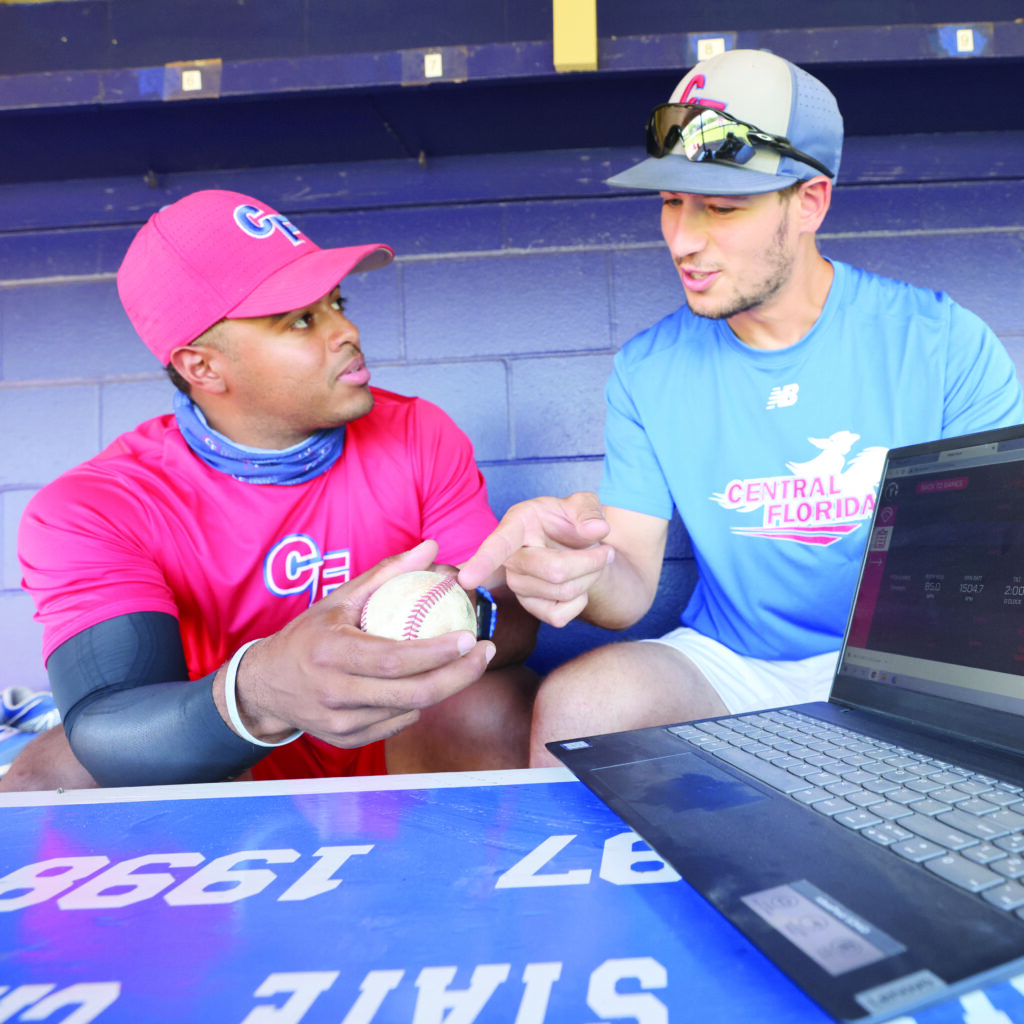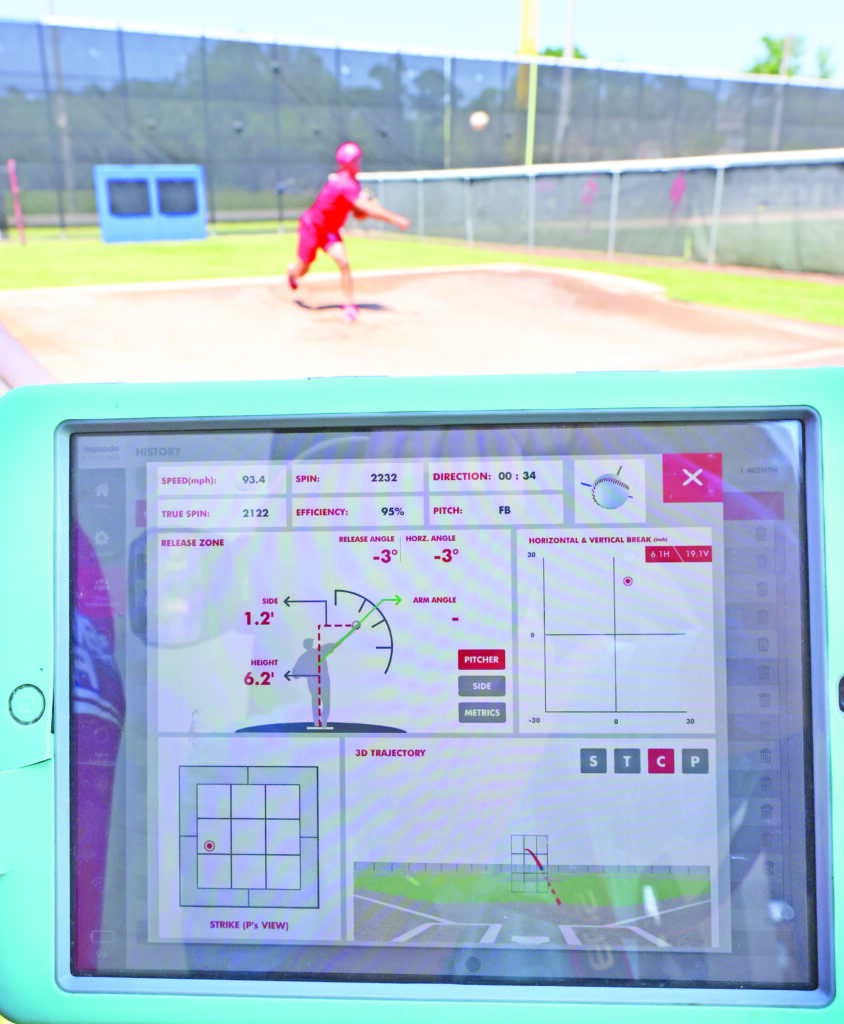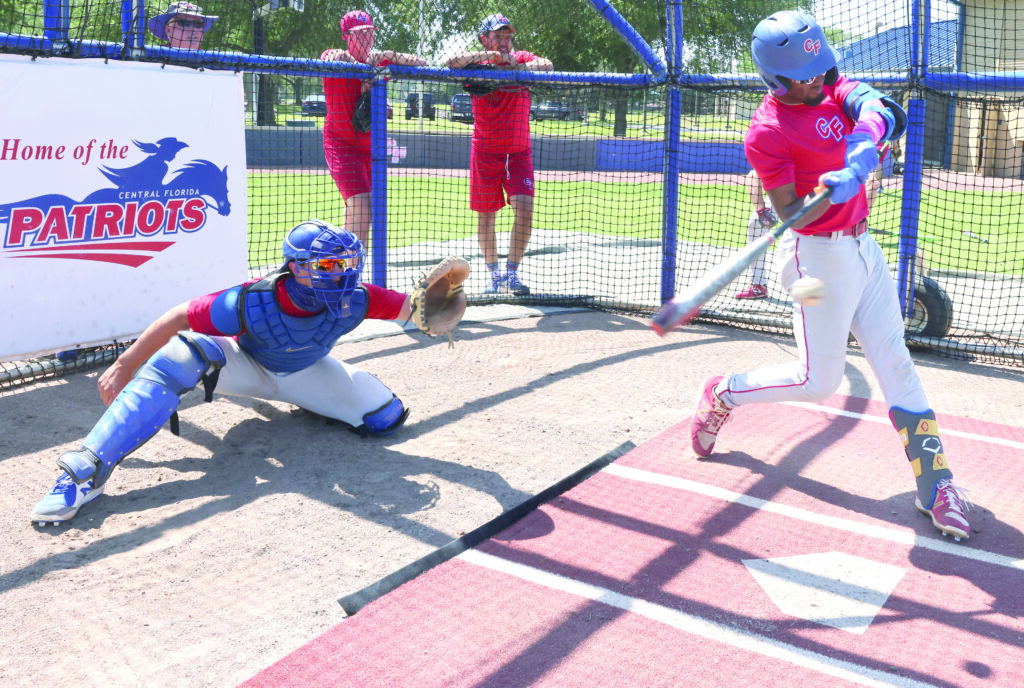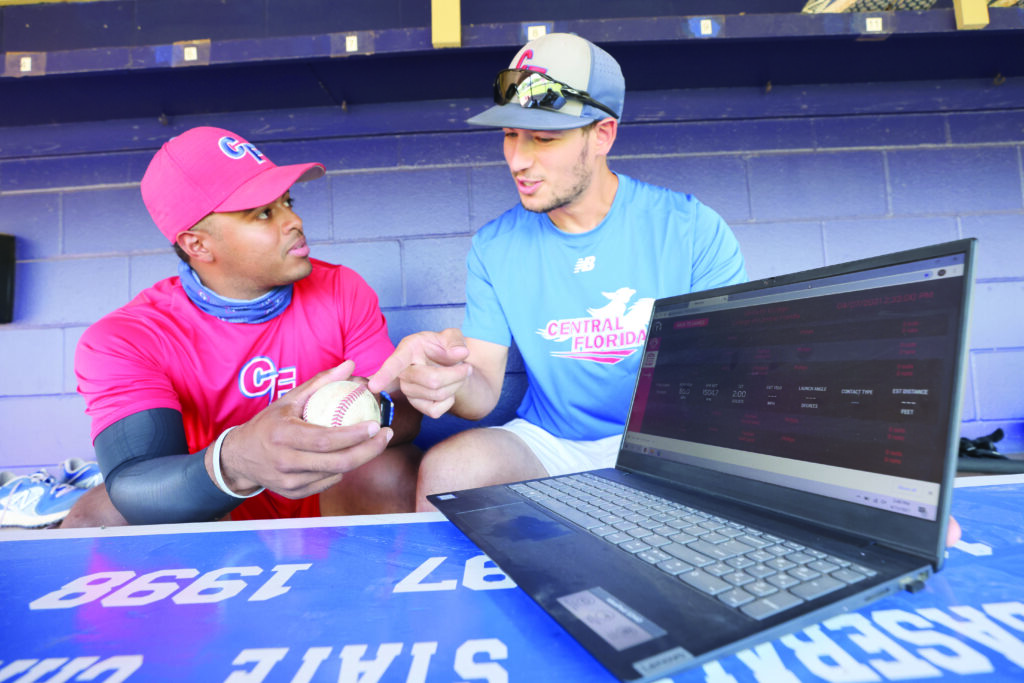On the cutting edge

Collin McBride, a data analyst coach, right, talks with pitcher Francisco Mateo, left, about his pitching, as data from the Yakkertech system is displayed on a laptop from their game against Santa Fe during practice at the College of Central Florida in Ocala, Fla. on Tuesday, April 13, 2021. Coach Marty Smith and the College of Central Florida baseball team use technology to improve their pitching and hitting by monitoring player stats during home and away games. The team uses both the Rapsodo Mobile Launch Monitor system and the Yakkertech stereo vision imaging system technologies. According to the Yakkertech website, the system: is a stereo vision imaging system that can provide fully accurate data on all the key elements of a pitched baseball or softball. This is the key difference in the Yakkertech technology versus any other portable or highly used system in baseball/softball today. The information is instantly shown on an app on a tablet (which comes with our product!), and the data is then stored and easily retrieved over time. The primary use of our product is geared toward pitching coaches, used to assist in both understanding the optimum performance of each pitch type as well as for improving performance and creating better pitch design. [Bruce Ackerman/Ocala Gazette] 2021.
CF Patriots baseball use technology that rivals the big leagues

Pitcher statistics are shown on the screen as pitcher Troy Britts throws in the bullpen during practice at the College of Central Florida on April 13. Coach Marty Smith embraced the use technology to improve their pitching and hitting. [Bruce Ackerman/Ocala Gazette]
In the College of Central Florida’s baseball dugout, coaches and players huddle around a sturdy wooden table. Painted on the table legs – in the team’s red, white and blue color scheme – is their four-step motto: Sleep Well, Eat Right, Lift Heavy, Hit Bombs.
But it’s what’s on the table that’s become the Patriot’s not-so-secret weapon.
During home games, it’s not uncommon to see one coach feeding play-by-play data into a computer on the table, while on another, players are charting every pitch. Pitchers and fielders with the day off gather around the table to debate the pitches thrown.
The table is the Patriots’ gameday operations center, complete with pro-level technology gathering a plethora of metrics. Pitching coach Zac Cole says the Pats are one of the most technologically advanced programs in the country across any level of collegiate baseball.
“I would venture to say that we’re more advanced on the technology than a lot of college baseball programs at any level and, you know, maybe even, you know, some professional teams,” Cole said. “We’re doing more on the technology side than what a lot of Major League Baseball teams were doing just a few years ago.”
Marty Smith’s tenure as Central Florida’s coach started before his players were even born. The two-time state champion earned his 800th career win in February. To have that kind of longevity and success, you must be willing to adjust as the game changes.
Technology and analytics are prime examples.
For the Patriots, it all started a few years ago with former pitching coach Zach Bove, who is now the assistant pitching coordinator for the Minnesota Twins. Bove, who Smith says secured a job in the majors because of his love of analytics, data and development, showed Smith the potential in using technology to help players improve.
“He got us in our foot in the door and then showed us some things that we could do, some things that would help us, some things that would get us from here to here with just showing guys how much they’re improving instead of telling guys how much they’ve improved,” Smith said. “You get a hard number on exit velocity, velocity, spin efficiency, how their pitch moves, how the ball’s coming off their bat, not to mention on the track side of things that we get from this program and just gains in the weight room, movement, screening to see how people move.”
Four cameras hang over the Central Florida dugout, part of the Patriots’ Yakkertech setup. The cameras catch the ball in flight from when the pitcher throws to the end of the play. With that, the Patriots track a wealth of data.

Tre Hondras swings as Connor Bishop catches during the Patriots’ practice at the College of Central Florida in Ocala. The team used high-end analytic technology to help improve players’ pitching and hitting. [Bruce Ackerman/Ocala Gazette]
“It’s able to capture every event that happens with a ball in flight, so it can capture exit velocity and tell us how far the ball traveled and the spin of the baseball that’s batted,” Cole said. “And also, on the other side of that is it can tell us, you know, the velocity of the pitch, you know, the spin direction and all the different metrics of the spin of the baseball. So those things are really valuable in us developing our guys and having them be more effective in what they’re trying to do.”
An ad for Yakkertech runs across the bottom of the scoreboard at Goodlett Field, CF’s home field, right next to one for Baseballcloud, another baseball analytics service. The data from Yakkertech comes back in the form of a spreadsheet that the coaches then put into Baseballcloud. From there, the coaches can show their hitters where they’re hitting well or poorly, and the pitchers can see where their pitches have been the most effective.
“It’ll show you every pitch that you threw, you know, and you can sort any date range you want,” Cole said. “You could show the last month, you could show the last week, you could show the last single outing, and you can sort that whole thing. And it’s going to give you all that actionable data where you can see, ‘Hey, when I throw my curveball here, it’s really effective. When I throw it here, it’s not very effective.’”
The introduction of Statcast, the MLB’s tracking technology, in 2015 helped popularize metrics like exit velocity (how fast the ball comes off the bat) and launch angles (the angle at which the ball is hit), along with a mile-long list of other trackable metrics.
Being able to track exit velocity, for example, can be incredibly useful for both pitchers and hitters. The idea is that pitches that are smacked harder are more likely to turn into hits, which can turn into more runs. A struggling hitter can see that he has been a little unlucky if he’s been hitting balls hard directly at fielders, or pitchers can see when they dodge a bullet when a hanging curveball gets drilled only to get caught at the warning track.
It’s one thing for Major League teams to have the technology to track those metrics, but it’s a different story for junior college teams like Central Florida. Smith said Baseballcloud and Yakkertech installed their systems at Goodlett Field at no cost as part of a pilot program for their products.
All players have access to their data and can look at their reports while they’re studying in the library, killing time between classes or relaxing in their dorms. Additionally, pitchers will receive a post-game “report card” showing their velocity and pitch locations to show them what worked and what didn’t in that outing. For redshirt sophomore Evan Michelson, a relief pitcher from Jacksonville, Florida, being able to look at his pitches’ spin efficiency (how much the ball “breaks” when thrown) is important.
“I’d say it’s one of the bigger things,” he said. “Getting your ball to move evenly is something that helps a lot of with the way your pitches move and how far they move away from their origin of the pitch.”
Players have been responsive to the Patriots’ new-age player development program, and the Pats actively recruit players who are open to the technology side, such as freshman Shawn Guilliams. They’ve seen how it’s being used in the majors and how it’s now trickling down to junior college baseball.
“It obviously helps because I think these amateur players are seeing what’s happening on the professional level, so they’re seeing the impact that technology has made on professional guys,” Cole said. “So, they obviously want to be in an environment where people are doing things like that, so that makes us attractive on a couple of different levels. But the big thing for us is finding guys that want to do the things we’re doing because that’s how we get the most out of them.”
The Patriots think that they have a significant advantage because they can show their players their exact strengths and weaknesses. Cole estimates that there are 100 on-field tracking technology units across all levels of college baseball, six of which are Yakkertechs in Florida.
He recalls how the College of Central Florida was the first school of any level to acquire a Rapsodo unit, which also tracks pitches, and the bigger schools in the state followed right behind them.
“They were calling here asking like, ‘Hey, how do we use this dang thing?’” he said.
Things get a little more complicated when the Patriots hit the road, as the Yakkertech cameras aren’t portable. But they’re still able to use the Rapsodo unit to give pitchers feedback, and they can chart pitches by hand. Still, the Patriots think that they’re ahead of the curve.
“I like to keep that quiet,” Smith says with a laugh. “I don’t want other teams to catch us. I think it’s a tremendous advantage for us and our players. But I’m not going to go out there bragging about it because if they don’t want to buy in, I’m fine with that.”
It’s not just computers and fancy stats for the Pats, though. Smith and the rest of the staff have also bought into more modern player development practices.

Collin McBride, a data analyst coach, right, talks with pitcher Francisco Mateo, left, about his pitching, as data from the Yakkertech system is displayed on a laptop from their game against Santa Fe during practice at the College of Central Florida on April 13. [Bruce Ackerman/Ocala Gazette]
Bove approached Smith in 2016 about a book called “Hacking the Kinetic Chain,” which was written by Kyle Boddy, the founder of the baseball performance company Driveline Baseball. Along with the book came a set of weighted plyometric balls and bands. The $450 price tag was a bit steep, but it was the first step the program took toward modernizing player development.
There was another book that Smith cites as being influential on the program: a book called “Practice Perfect.” One of the chapters in the book is about an 80/20 rule about practicing the stuff you use 80% of the time and less of the less important aspects of the game.
“If we’re out here for two-and-a-half hours for practice, those two-and-a-half hours we’re going to be doing stuff that is going to get them better,” Smith said.
The big change is the Patriots’ focus on getting players bigger, keeping them eating and lifting and, eventually, increasing their pitchers’ velocity. Long-distance running was one of the old baseball practices eliminated from CF’s program, as Smith believes that the game is more about explosive speed than endurance. Running poles – a recovery exercise for pitchers where they run from one foul pole to the other – is no longer a requirement in Smith’s program, much to the chagrin of his former players.
“My former coaches, we’ll put something on Twitter, my former players from 15-20 years ago go ‘What the h-ll are you doing,’” Smith said. “Gotta change with the times, man. They understand it, but it’s like ‘Geez, we didn’t do this, I wish we didn’t have to run poles, I wish we didn’t have to run distance and everything else.’”
Adjacent to the Central Florida dugout is a room with another table dedicated to feeding hungry Patriots with peanut butter and jelly sandwiches. This way, the players can always eat something, even during games.
“I want them always eating and gaining weight and getting stronger,” Smith said as shortstop Edrick Felix walks behind him to fix himself a sandwich. “We want to get them better when they leave here. We want them to be physically bigger. We want them to be better players. We want all of their numbers, their exit (velocity), their bench, their deadlift, their squat, their sprint time, their velocity, everything to be better when they leave here. The byproduct is it wins us some games.”
For Smith, Central Florida’s revamped focus on player development with the help of technology has revitalized his coaching tenure. Smith won back-to-back state championships in 1997 and 1998, but complacency started to set in during the years that followed.
“Since we’ve been doing this, we’ve won a lot of games, which isn’t even the goal,” Smith said. “The goal is to develop players and get ‘em better. It’s a by-product of what we’ve done. It’s rejuvenated me coming to the field every day to get players and knowing when kids leave, we got them better, we got them bigger, we got them stronger. We got them going to good schools or getting drafted.”





